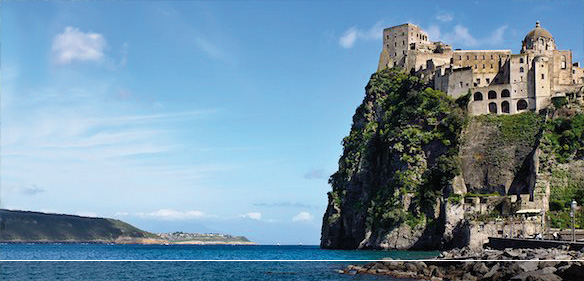|
|
ISLAND OF ISCHIA
Recent studies have, by now verified, that the island of Ischia was inhabited since the Prehistory. In the different places of the island, especially in the inside parts, tools have been found again in flint and ossidiana of the III Millennio B.C., as also ceramics fragments of the age of the Bronze and the Iron.
Because of one of the so many upsettings of the nature, the eruption of the island of Ischia was caused by the strength of the magma that lifted her/it from the seabed in a night of an it was distant when unknown to the same geologists. The first sod that came out was the peak of the Epomeo mountain. Following eruptions formed the various hills. Today, fortunately, the volcanic activity of the island of Ischia and limited to the presence of the thermal waters, to the existence of numerous fumarole with temperatures of 106 degrees. The man's appearance on the island happened in the age neolitica and to St. Michael under a layer of volcanic ash, fragments of belonging vases to this period have been found. The following development of the civilizations they were: 1) Neolitico; 2) age of the bronze; 3) age of the iron.
The first human installation was that of the Greek that occupied the high ground of Mountain Vico and they called the island 'Pithekussai' and they held her/it fit for their commerces in the Mediterranean. Subsequently the Romans changed his/her norne in 'Aenaria' and they valorized his/her thermal waters and particularly those of Nitrodi, where representative bas-reliefs the nymphs of Nitrodi have been found again. After the undoing of the Roman empire, Ischia was invaded by the various Barbaric people gone down in Italy. In the Middle Ages, in a letter sent to the pope Leone III to the emperor Charles Magno in 813, for the first time Ischia is called with the norne of 'Insula' (island for excellence), contaminated him in the time in Insla, Isla, Iscla and finally, Ischia.
With the end of the Dukedom in Naples, the island of Ischia followed the fates in Naples. I pass under the dominion of the Norman ones, of the Svevis, of the Angioinis and of the Aragonese ones. Following the 1301 Trippodi Mountain eruption, the inhabitants ran away in firm earth and after 4 years they were picked up on the islet of the Castle. In the 1320 Roberto of Angiņ it visited the Castle together with his/her/their wife Sancia in Majorca. With the new dynasty begun by Alfonso I in Aragon, the Castle became a strengthened citadel and impregnable.
|
|











